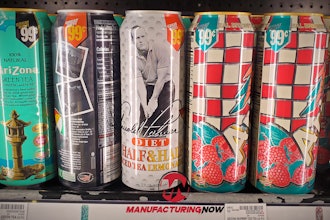Use of the term “a win-win” in the business world has become a cliché. However, because this article will address how the green movement today permeates throughout the metal forming and fabricating industry, it’s certainly appropriate to “recycle” the phrase here.
Indeed, for this vital segment of the manufacturing world, which bends, cuts, extrudes, fastens, finishes, levels, punches, shears, stamps, welds and assembles components made from sheet or structural metal to create products of all kinds, the surge in sustainable manufacturing practices is a significant win-win. First, efforts by manufacturers to preserve our precious natural resources are positive from an altruistic perspective. And, second, such measures can deliver cost-saving benefits both in the short term and long term.
A 2009 study by Aberdeen Group on the sustainability initiatives conducted by more than 200 companies, many in manufacturing, illustrates this dual benefit. Those deemed “best in class” achieved a significant 9% reduction in carbon footprint while cutting energy costs by 6%, facilities costs by 7%, paper costs by 10% and transportation/logistics costs by 7%. Talk about win-win!
Fabricators Are Engaged
Such statistics help pinpoint the benefits of the green movement. In our industry, many new developments have evolved that dramatically show how the fabricating segment of manufacturing is increasingly engaged in green practices.
One striking example is the new Green Manufacturer magazine from Fabricators & Manufacturers Association (FMA) Communications, Inc., which publishes several industry trade journals. Even in this turbulent economy, the publishers felt the time was right to take a risk and launch this new title. In the debut January/February issue, Editor Kate Bachman explained why, stating, “With increasing frequency, we have received requests from manufacturers looking to implement sustainable practices, which convinced us that the time is right to look at manufacturing through a green filter.”
Several issues already are off the press, featuring coverage on green manufacturing initiatives, eco-friendly equipment and products, manufacturers with successful sustainability stories, and government updates. Many other journals in our industry are devoting similar coverage to green issues.
Government Programs Are Green Catalysts
These same publications also often describe new “assistance” programs, many established by government entities, available to manufacturers to help create their sustainable programs. One growing in popularity in our industry is the Green Suppliers Network established by the U.S. Environmental Protection Agency in collaboration with the U.S. Department of Commerce. Its mission is to help small and medium-sized manufacturers stay competitive and profitable while reducing their impact on the environment.
This is accomplished via the network’s “Lean and Clean Advantage.” The program works with large manufacturers to engage their suppliers in low-cost technical reviews to identify strategies to improve process lines, use materials more efficiently and eliminate the root causes of waste.
Other collaborations have formed to further spur the green movement. For example, the Society of Manufacturing Engineers recently teamed with the American Wind Energy Association and the Canadian Wind Energy Association to support development of the wind energy supply chain in the U.S. and Canada and help manufacturers transition to wind energy components.
Of course, there is a host of U.S. Department of Energy (DOE) initiatives. For example, the department offers the Industrial Technologies Program Save Energy Now that aims to drive a reduction of 25% or more in industrial energy intensity in 10 years. The DOE conducts a number of very ambitious energy efficiency research programs.
And, let’s not forget the very prominent Leadership in Energy and Environmental Design (LEED®) rating program. Created by the U.S. Green Building Council, LEED awards projects based on their use of sustainable materials and highly efficient equipment.
Trade Shows, Conferences Leaning Green
As one may expect, industrial education events and exhibitions today address green issues in a major way. Our industry’s largest trade show, FABTECH, is a prime example. At this year’s convention in Atlanta in November, one keynote presentation is titled, “Make Green by Going Green: How Manufacturers Can Gain a Competitive Advantage.” A panel will focus on how implementing a practical lean and green approach to consuming water, gas, utilities and raw materials can benefit both the environment and a company’s bottom line.
Several workshops at FABTECH this year will address green initiatives. They include more general presentations like conducting “green audits” and sessions on more specific topics such as how to be green with finishing systems, and tips on ways to convert to more energy-efficient factory lighting.
There also is a surge of industry events that focus solely on green issues. One is the Lean to Green Manufacturing Conference this fall in Columbus, Ohio, planned by the Society of Manufacturing Engineers. Using lean manufacturing principles as the base, this four-day session features industry leaders sharing their experiences for improving environmental impacts, eliminating waste and maximizing green benefits.
Moving From Theory to Real-Life
Without a doubt, the discussions, educational programs and media coverage are having an impact. Manufacturers in our industry are aggressively implementing green tactics. Here are just a few examples from the many occurring across the country:
- DeWys Manufacturing, Grand Rapids, Mich., a precision fabricator, learned from an environmental audit that reducing wastewater was an area it should target. Through increase employee vigilance and better monitoring of equipment, the company cut its annual water usage by 58%.
- Aqua Lung, Vista, Calif., a manufacturer of diving and snorkeling equipment, installed a “daylighting” system that which harnesses natural daylight in its 60,000-square-foot facility. Through the use of photocontrols and a dedicated phone line to the local utility to monitor usage, the site achieved an immediate electricity consumption reduction of 33%.
- Rapid-Line Inc., Grand Rapids, Mich., a full-service fabrication and tooling shop that designs, manufactures and finishes metal products, initially focused its green efforts on natural gas consumption. Implementing a variety of measures, such as installing insulation and industrial-grades fans to capture and redirect excess heat from its paint line ovens, Rapid-Line reduced its natural gas consumption significantly while saving $46,000 annually.
- AGS Technology, Schaumburg, Ill., an injection molder, sources recycled plastic and formulates the raw material in-house to make molded components for companies primarily in the automotive and durable goods industries. This environmentally conscious tactic also delivers significant cost savings for AGS and its customers.
This list can go on and on. Even here at FMA headquarters we’re following the green trend. Through the installation of energy efficient fixtures, we will save $35,000 annually on our lighting bill. It’s clearly evident that the number of companies in metal forming and fabricating that will “go green” and keep “growing green” at their facilities, large and small, will escalate every year. Yes, when that happens, everyone involved in the process is a winner.
___
About the author: Gerald Shankel is president and chief executive officer of Rockford, Ill.-based Fabricators & Manufacturers Association, International (FMA), a professional organization with more than 2,100 members working together to improve the metal forming and fabricating industry together through technology councils, educational programs, networking events, seven industry magazines and the FABTECH Show. FMA also has a technology affiliate, the Tube & Pipe Association, International (TPA), which focuses on the unique needs of companies engaged in tube and pipe producing and fabricating.


















